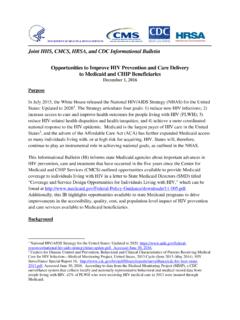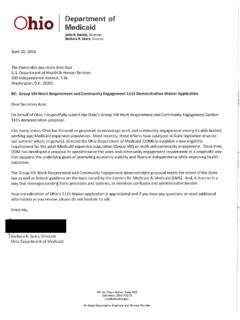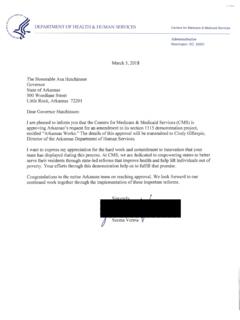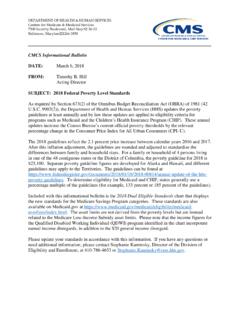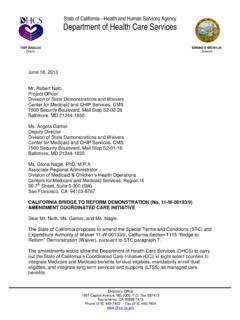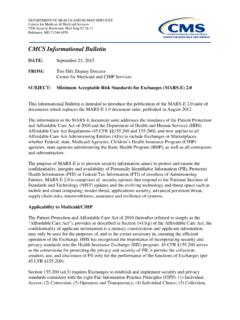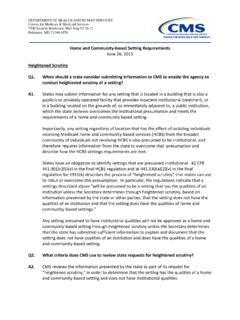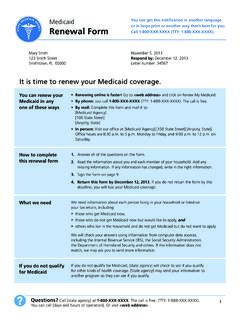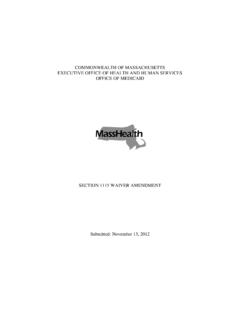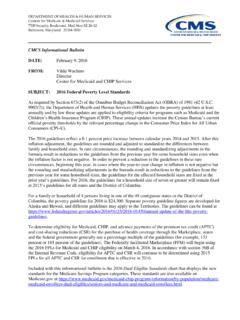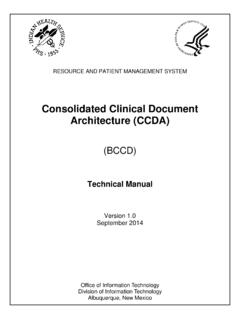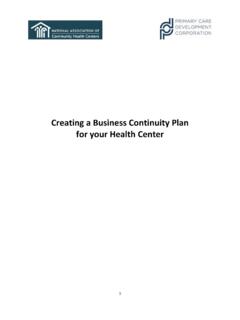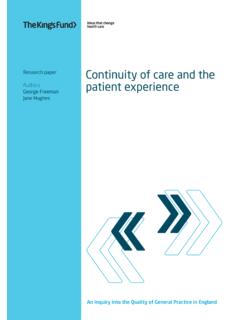Transcription of Overview of Strategic Approach to Engaging Managed Care ...
1 1 Overview of Strategic Approach to Engaging Managed care Plans to Maximize continuity of Coverage as States Resume Normal Eligibility and Enrollment Operations MARCH2022 UPDATEThis communication was printed, published, or produced and disseminated at taxpayer expense. The information provided inthis document is intended only to be a general informal summary of technical legal standards. It is not intended to take the place of the statutes, regulations, or formal policy guidance that it is based upon. This document summarizes current policy and operations as of the date it was presented. We encourage readers to refer to the applica ble statutes, regulations, and other interpretive materials for complete and current information. The COVID-19 pandemic and implementation of federal policies to address the resulting public health emergency (PHE) have disrupted routine Medicaid and Children s Health Insurance Program (CHIP) eligibility and enrollment operations. Medicaid and CHIP program enrollment has grown by 20 percent since February 2020 and, as of September 2021, nearly 85 million individuals were enrolled across the programs.
2 This growth in enrollment in large part is due to the continuous enrollment requirements that states implemented in Medicaid as a condition of receiving a temporary percentage point federal medical assistance percentage (FMAP) increase under section 6008 of the Families First Coronavirus Response Act (FFCRA). As described in State Health Official Letter #21-002, Updated Guidance Related to Planning for the Resumption of Normal State Medicaid, Children s Health Insurance Program (CHIP), and Basic Health Program (BHP) Operations Upon Conclusion of the COVID-19 Public Health Emergency, states will have a 12-month unwinding period to complete all pending post-enrollment verifications, redeterminations, and renewals following the end of the PHE. CMS is working closely with states and other stakeholders to ensure, as states resume routine operations, that renewals of eligibility occur in an orderly process that minimizes beneficiary burden and promotes continuity of coverage for eligible individuals, including those who no longer qualify for Medicaid or CHIP and therefore may transition to a different form of coverage, such as through a I t may have been several years since some beneficiaries have had to complete renewals for Medicaid, which means states may have outdated contact information.
3 Without updated contact information, notices, renewal packets, and/or requests for additional information may not reach individuals who have moved, leading to inappropriate coverage loss among individuals still eligible for coverage. Additionally, as states return to normal eligibility operations, some individuals may need assistance to complete required actions such as submitting additional documentation to confirm Medicaid or CHI P eligibility, or enrolling in Marketplace coverage with financial assistance. Close collaboration between states and Managed care plans can help ensure eligible enrollees retain coverage in Medicaid and CHIP and ease transitions for individuals eligible for coverage through the Marketplace. Managed care plans can support states in their efforts to promote continuity of coverage for eligible individuals by: Helping individuals enrolled in their Medicaid Managed care plan complete the renewal process; Minimizing churning due to loss of coverage for procedural reasons; and Facilitating transitions from Medicaid to the Marketplace where appropriate.
4 The strategies in this presentation are permissible and consistent with federal Medicaid and CHI P policies. States need to consider whether state-specific laws or contract provisions may present barriers that prevent adoption of these Managed care Plans to Prepare for Return to Regular Eligibility and Enrollment with Plans to Obtain and Update Beneficiary Contact Renewal Files with Plans to Conduct Outreach and Provide Support to Individuals Enrolled in Medicaid during their Renewal Plans to Conduct Outreach to Individuals Who Have Recently Lost Coverage for Procedural Plans to Assist Individuals to Transition to and Enroll in Marketplace Coverage if Ineligible for Medicaid and CHIPKey Strategies for Working with Managed care Plans4 Approach : States accept from Managed care plans updated enrollee contact information, including mailing addresses, telephone numbers, and email addresses. Medicaid and CHIP agencies may treat this information as reliable and update the beneficiary record with the new contact information from the health : States should ensure that plans ONLY provide updated contact information received directly from or verified by the beneficiary, and not from a third party or other source.
5 Plans that receive third party address updates from providers, delegated entities, or others may transmit information to states if the plan confirms the accuracy of the information with the enrollee and receives a response. Updated contact information should notbe transferred to the Medicaid agency if received by a third party, without confirmation from the member. Strategy 1: Partnering with Plans to Obtain and Update Beneficiary Contact Information5 Requirements/Considerations: When updated address information is received from Managed care plans, states must send a notice to the individual s original address on file with the agency, using the beneficiary s preferred mode of communication, and must provide the individual with a reasonable period of time to dispute the accuracy of the new contact information. If the beneficiary does not respond, states may treat the updated information received from the health plan as verified and update the beneficiary s information in the case file.
6 States are also strongly encouraged to contact the beneficiary through other modalities, such as via telephone, electronic notice, email, or text message, to inform them of the updates to their contact information. Through the end of the unwinding period, under the authority at 1902(e)(14)(A) of the Social Security Act, CMS will approve waivers providing flexibility to states to forego the requirement to contact the beneficiary to confirm the updated contact information prior to accepting the health plan s information as verified. This flexibility is available only on a temporary basis, to states with systems or operational constraints that prevent them from providing the individual with an opportunity to dispute the accuracy of the new contact information. States should contact CMS for additional information and to request a 1: Partnering with Plans to Obtain and Update Beneficiary Contact Information (Cont d)6 Requirements/Considerations (Cont d): To assist members in updating their contact information, Managed care plans may also instruct individuals to update their contact information directly with the state agency and provide assistance to do so.
7 Assistance may be provided to update information online through a member portal, by calling the state s call center while the member is on the line to provide updates, or via warm phone transfers to the call center. Providers, Managed care plans subcontractors, or other third-parties may also provide assistance to members to update contact information directly with the 1: Partnering with Plans to Obtain and Update Beneficiary Contact Information (Cont d)7 Implementation Consideration: States adopting this strategy should review and revise any necessary contracts and protocols to ensure successful implementation. In establishing agreements with plans, states may consider setting guidelines for the information to be shared, such as the maximum age and type of contact information received from health plans, and should ensure that any information sharing is consistent with applicable law ( , HIPAA privacy rules). Implications for enrollees enrolled in both Medicaid and SNAP: If Medicaid and SNAP are within the same state agency and considered co-located ( , in an agency with an integrated eligibility system), SNAP can accept Medicaid s updated address without further verification so long as it is not questionable or unclear.
8 Additional action is required for SNAP after an address is updated, as the state must solicit updated shelter costs and recalculate benefits without the excess shelter deduction if the household does not respond. Strategy 1: Partnering with Plans to Obtain and Update Beneficiary Contact Information (Cont d)8 Approach 1: States provide monthly files containing information about beneficiaries for whom the state is initiating the renewal process to their Managed care plans to enable plans to conduct outreach and provide assistance with the renewal process. Approach 2: States could use a similar Approach to support outreach to enrollees who have yet to submit their renewal form or additional documentation and are at risk of losing : When developing the process to share information with the Managed care plans, states should identify and address possible system or operational challenges in advance of resuming normal eligibility and enrollment operations. States should request that Managed care plans use additional modalities ( , phone, text) to conduct outreach to beneficiaries and encourage individuals to complete and return their renewal 2: Sharing Renewal Files with Plans to Conduct Outreach and Provide Support to Individuals Enrolled in Medicaid during their Renewal Period9 Medicaid Managed care plans have flexibility to provide information and conduct outreach to beneficiaries about the eligibility renewal process when the outreach to beneficiaries is not marketing or marketing activities within the scope of the Medicaid Managed care marketing regulations at 42 CFR When beneficiaries are losing their Medicaid or CHIP coverage, states and Managed care plans should consider utilizing the following strategies: Strategy 3.
9 States provide Medicaid Managed care plans with monthly termination files to enable plans to conduct outreach to individuals terminated from Medicaid for procedural reasons (such as not returning their renewal form timely). Strategy 4: States encourage Medicaid Managed care plans that also offer a Qualified Health Plan (QHP) to share information with enrollees who are determined ineligible for Medicaid to assist in the transfer of individuals to Marketplace coverage where When Beneficiaries Are Losing Medicaid or CHIP Coverage 10 There are nofederal regulatory barriers that prevent states and Managed care plans from working together to help individuals who are terminated from Medicaid or CHIP coverage, including transitions to other sources of coverage. States and Managed care plans should evaluate whether to utilize strategies 3 and 4 separately, or in combination, particularly when information may be limited regarding the reason a beneficiary may be losing coverage.
10 For example, states and Managed care plans should consider the following scenarios: Managed care plan knows the beneficiary is losing eligibility for procedural reasons Strategy 3 Managed care plan knows the beneficiary is losing eligibility for programmatic reasons Strategy 4 Managed care plan does not have information on why the beneficiary is losing eligibility Combination of Strategies 3 and 4 Strategies When Beneficiaries Are Losing Medicaid or CHIP Coverage 11 Approach : States provide Medicaid Managed care plans with monthly termination files to enable plans to conduct outreach to individuals terminated from Medicaid for procedural reasons (such as not returning their renewal form timely).Requirements/Considerations: Under the Medicaid Managed care marketing rules at 42 CFR , Medicaid Managed care plans cannot seek to influence enrollment in conjunction with the sale or offering of any private insurance (excluding qualified health plans (QHPs)). Medicaid Managed care plans cannot, directly or indirectly, engage in door-to-door, telephone, email, texting, or other cold-call marketing activities.
